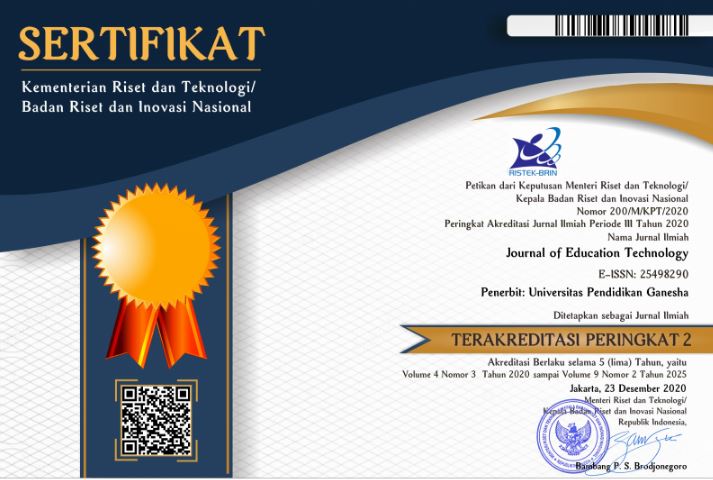Improving the Use of Learning Media through the Development of E-Storybooks for Fifth-Grade Students
DOI:
https://doi.org/10.23887/jet.v8i3.81100Kata Kunci:
E-Storybooks, Merdeka Curriculum, Supplementary Material, Young LearnerAbstrak
The availability of supplementary materials in learning needs to be improved. Due to the change in curriculum, it was difficult for teachers to prepared materials so that they only rely on textbooks. Therefore, this research was conducted on the development of e-storybooks integrated with the Merdeka Curriculum for fifth-grade students. This research aimed to produced e-storybooks that were interactive, innovative, interested and integrated with the Curriculum. Design and Development (D&D) model used in this research which included four stages namely Analysis, Design, Development, and Evaluation, which combined with qualitative and quantitative methods. First, learning problems, teacher and students’ interviews, and document were analyzed. Second, it continued with the development of blueprints related to the developed topics and then the creation of product layouts. The third stage, the e-storybooks were developed by Canva and Book Creator, then revised according to the experts’ feedback and judged by experts. The last stage, conducted product trial, interviews, and product quality judgment which involved teacher and students. This research resulted e-storybooks that were maximally beneficial, being useful as good alternative learning media for language learning, vocabulary development and interested learning experienced for students. Through the results of this study, e-storybooks can be a new alternative as supplementary materials to support learning so that teachers should maximize the use of supplementary materials that are integrated with the curriculum and technology.
Diterbitkan
Cara Mengutip
Terbitan
Bagian
Lisensi
Hak Cipta (c) 2024 Ni Putu Riza Clarita Pitaloka, G.A.P Suprianti, Luh Gede Eka Wahyuni

Artikel ini berlisensiCreative Commons Attribution-ShareAlike 4.0 International License.
Authors who publish with the Journal of Education Technology agree to the following terms:
- Authors retain copyright and grant the journal the right of first publication with the work simultaneously licensed under a Creative Commons Attribution License (CC BY-SA 4.0) that allows others to share the work with an acknowledgment of the work's authorship and initial publication in this journal.
- Authors are able to enter into separate, additional contractual arrangements for the non-exclusive distribution of the journal's published version of the work (e.g., post it to an institutional repository or publish it in a book), with an acknowledgment of its initial publication in this journal.
- Authors are permitted and encouraged to post their work online (e.g., in institutional repositories or on their website) prior to and during the submission process, as it can lead to productive exchanges, as well as earlier and greater citation of published work. (See The Effect of Open Access)

















